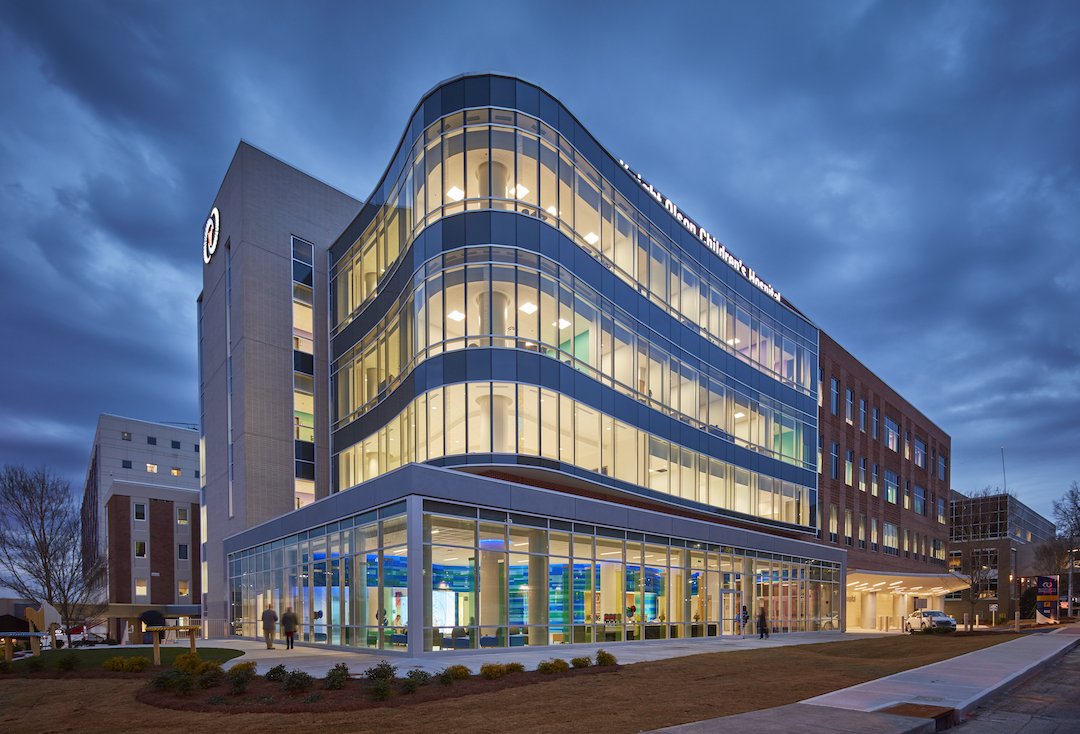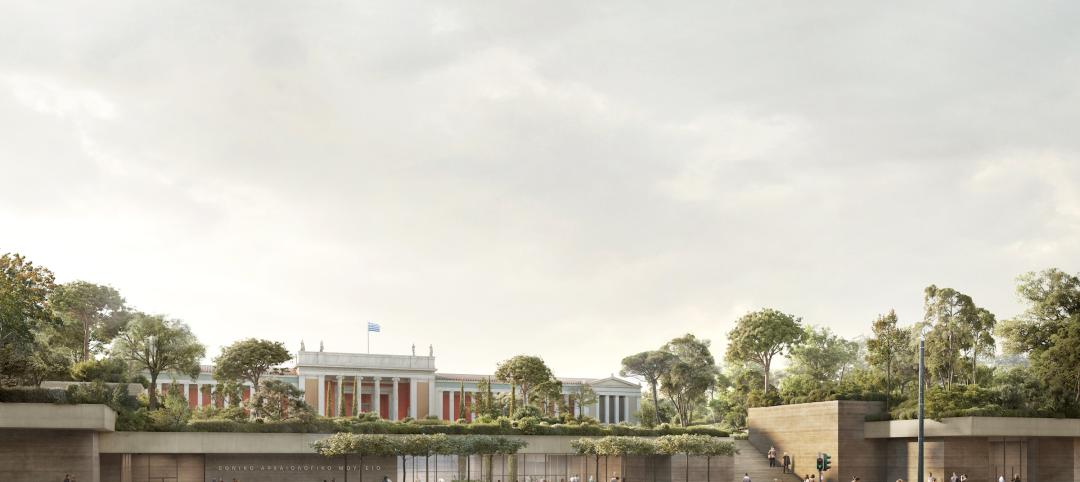Upgrades to medical equipment and systems and improvements to building systems are the current focus in the healthcare market.
Healthcare consolidation contributes to this trend. After larger health systems acquire smaller, rural facilities, there’s typically a push to renovate them and upgrade technology, says Robin Savage, President/COO, Robins & Morton. “A lot of this work is centered on diagnostic and imaging and service areas like women’s services,” says Savage.
The next big advancement: the so-called “smart hospital.” With multiple systems able to communicate with each other, such a building perform functions like another medical practitioner.
At the $1.6 billion Mackenzie Vaughan Hospital, now under construction in Toronto, building systems and medical technology will be linked. When a patient’s monitor detects a heart attack, it will send a silent alert to critical care response team members equipped with wearable location services badges. The badges will automatically override elevator controls, giving team members express service to the patient’s floor.
ALSO SEE: Top 150 Healthcare Architecture Firms
ALSO SEE: Top 90 Healthcare Engineering Firms
ALSO SEE: Top 100 Healthcare Construction Firms
Engineering giant WSP is examining ways to deploy Amazon Echo to aid HIPAA compliance and patient safety, says WSP’s Gary Hamilton, Senior Vice President and Eastern Healthcare Lead. Alerts could be sent to surgical recovery nurses every four hours to ensure that patients receive pain medication on time.
Smart hospitals will also boost energy efficiency. Artificial intelligence would analyze data from building management systems and scheduling software to determine how best to use space. Knowing that a patient was just discharged, smart building technology could turn down the HVAC in the empty room and punch it back up when the room is scheduled to be reoccupied.
Using fiber optic systems throughout the building, MEP systems can be integrated with low-voltage systems such as AV and alarm systems. Once linked, these systems can enable smart hospital features. “In five years, the occupant-aware building is going to be commonplace in healthcare,” says Hamilton.
BIM and virtual reality are being used to analyze how healthcare medical professionals use space. “As we design key clinical spaces, we are mapping travel distances,” says Kate Renner, AIA, LEED AP BD+C, Design Researcher and Architect, HKS Inc. The data populates detailed behavior maps, which inform the creation of digital renderings that can be experienced in VR.
HKS also creates full-scale cardboard mockups of key spaces such as inpatient rooms and surgical suites that provide valuable feedback from medical personnel on the positioning of equipment, cabinetry, and sinks.
Coping with natural disasters also figures into the early stages of programming and design. A sudden influx of patients from a hurricane, tornado, or earthquake could be accommodated if emergency rooms were equipped with double medical gas outlets in headwalls so that trauma victims could be doubled up in each room. Post-anesthesia care units outfitted with extra medical gas and headwall capacity could also function as emergency care units following a disaster, says Renner.
Structural dampeners and reinforced stabilizers for overhead MEP systems are being required in earthquake-prone areas. After Mercy Hospital, Joplin, Mo., was destroyed by a tornado in 2011, collapsed MEP assemblies were found to be the major source of damage, says Renner. To make the replacement structure more resilient, the design also included reinforced stabilizers for the MEP systems, laminated safety glass, reinforced stairwells, battery-powered lights, and wall hooks that can be used to ease patients down stairs with sleds and ropes.
Owners of critical facilities have increased their supply of water storage and generator fuel, Hamilton says. The Veteran’s Administration now requires a two-week supply of water, not the previous one-week standard.
Offsite construction ON THE UPSWING in healthcare sector
Prefab construction of mechanical systems continues to grow. “At least one headwall manufacturer is now including ductwork and insulation,” says Hamilton. “At most trade shows, we’re seeing four or five prefab bathroom manufacturers.”
Prefab exterior wall systems are an increasingly compelling option, says Tim Johnson, Vice President/Division Manager, Brasfield & Gorrie. Evaluating prefab options is a task owners now count on their project teams to assess.
Lean construction is also in demand. “At least three out of four RFPs that we see address Lean management and Lean construction,” Savage says. Contractors must be involved earlier than ever to provide cost and constructability analysis. “Architects and GCs are now being selected at about the same time,” says Johnson.
“During pre-construction, owners require you to commit expensive and knowledgeable resources at the beginning—as much as 12 months before breaking ground,” says Savage. The extra effort does make for an improved architect-contractor relationship, says Hannah Wickham, Vice President, Business Development, Brasfield & Gorrie.
MORE FROM BD+C'S 2019 GIANTS 300 REPORT
Related Stories
Airports | Feb 28, 2023
Data visualization: $1 billion earmarked for 2023 airport construction projects
Ninety-nine airports across 47 states and two territories are set to share nearly $1 billion in funding in 2023 from the Federal Aviation Administration. The funding is aimed at help airports of all sizes meet growing air travel demand, with upgrades like larger security checkpoints and more reliable and faster baggage systems.
Seismic Design | Feb 27, 2023
Turkey earthquakes provide lessons for California
Two recent deadly earthquakes in Turkey and Syria offer lessons regarding construction practices and codes for California. Lax building standards were blamed for much of the devastation, including well over 35,000 dead and countless building collapses.
Sports and Recreational Facilities | Feb 27, 2023
New 20,000-seat soccer stadium will anchor neighborhood development in Indianapolis
A new 20,000-seat soccer stadium for United Soccer League’s Indy Eleven will be the centerpiece of a major neighborhood development in Indianapolis. The development will transform the southwest quadrant of downtown Indianapolis by adding more than 600 apartments, 205,000 sf of office space, 197,000 sf for retail space and restaurants, parking garages, a hotel, and public plazas with green space.
Architects | Feb 27, 2023
Hord Coplan Macht announces retirement of Founder/CEO Lee Coplan, FAIA, and names successor
Hord Coplan Macht, an award-winning integrated architecture, interior design, landscape architecture, and planning firm, announces the retirement of Founder and Chief Executive Officer Lee Coplan, FAIA. Lee leaves behind a long and celebrated career leading the practice over the last four decades while bringing innovative design strategies and leadership to the architecture and design community.
Libraries | Feb 26, 2023
A $17 million public library in California replaces one that was damaged in a 2010 earthquake
California’s El Centro community, about two hours east of San Diego, recently opened a new $17 million public library. With design by Ferguson Pape Baldwin Architects and engineering services by Latitude 33 Planning & Engineering, the 19,811-sf building replaces the previous library, which was built in the early 1900s, damaged by a 7.2 earthquake that struck Baja California in 2010, and demolished in 2016.
Architects | Feb 24, 2023
7 takeaways from HKS’s yearlong study on brain health in the workplace
Managing distractions, avoiding multitasking, and cognitive training are key to staff wellbeing and productivity, according to a yearlong study of HKS employees in partnership with the University of Texas at Dallas’ Center for BrainHealth.
University Buildings | Feb 23, 2023
Johns Hopkins shares design for new medical campus building named in honor of Henrietta Lacks
In November, Johns Hopkins University and Johns Hopkins Medicine shared the initial design plans for a campus building project named in honor of Henrietta Lacks, the Baltimore County woman whose cells have advanced medicine around the world. Diagnosed with cervical cancer, Lacks, an African-American mother of five, sought treatment at the Johns Hopkins Hospital in the early 1950s. Named HeLa cells, the cell line that began with Lacks has contributed to numerous medical breakthroughs.
Arenas | Feb 23, 2023
Using data to design the sports venue of the future
Former video game developer Abe Stein and HOK's Bill Johnson discuss how to use data to design stadiums and arenas that keep fans engaged and eager to return.
Museums | Feb 22, 2023
David Chipperfield's 'subterranean' design wins competition for National Archaeological Museum in Athens
Berlin-based David Chipperfield Architects was selected as the winner of the design competition for the new National Archaeological Museum in Athens. The project will modernize and expand the original neoclassical museum designed by Ludwig Lange and Ernst Ziller (1866-1874) with new spaces that follow the existing topography of the site. It will add approximately 20,000 sm of space to the existing museum, as well as a rooftop park that will be open to the public.
Multifamily Housing | Feb 21, 2023
Watch: DBA Architects' Bryan Moore talks micro communities and the benefits of walkable neighborhoods
What is a micro-community? Where are they most prevalent? What’s the future for micro communities? These questions (and more) addressed by Bryan Moore, President and CEO of DBA Architects.

















